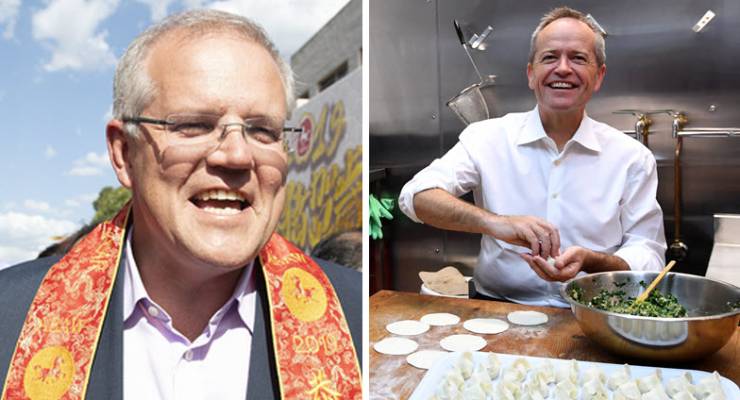
It speaks volumes about both Australia and its political parties that is only in 2019 they have “discovered”, and are openly campaigning for, the support of Chinese-Australian voters.
Chinese-Australians are the largest non-European ethnic group in the country; the raw numbers, 1.2 million, speak for themselves. And though this is obviously a figure that is electorally significant, there is far more complexity than this simplistic term implies.
The Chinese immigration boom in Australia, Canada and scores of other Western and developing countries has been underway for decades. Over the past 20 years, the Chinese-born population in Australia has grown larger than other migrant communities from Italy, Vietnam and Greece. This is largely a result of the Chinese economic boom, which has triggered a rise in university students (Chinese students comprise about a third of Australia’s international students) and Chinese tourist numbers. The latter has boomed so quickly, they are now our No. 1 customer.
In the three years since the last federal election, there have been a number of key debates emerge on China’s relations to Australia — particularly in relation to Chinese influence in academia, media and politics. In tandem, concern about Chinese investment has risen, pushed along by xenophobic politicians in the National and One Nation parties in particular. In urban areas the charge is “pushing up property prices”, and in regional areas it is both “buying the farm” and engaging in the controversial gas-extraction process of fracking.
But perhaps the most immediate driver of the Chinese-Australian focus this federal election was the cautionary tale of NSW Labor leader Michael Daley at the end March state election campaign. The less than charismatic Daley had unexpectedly appeared to have moved his party to within a sniff of victory, despite only being six months into the job. Three days out from the poll, his opponents dropped a video of him saying that Asian PhD students were talking Australian jobs. It was a seen by psephologists as a major driver of well above average swings towards the Liberals in Chinese-Australian heavy seats like Hurstville that went close to flipping a long-time Labor sinecure.
Daley’s self-immolation sent a powerful message to the federal party campaign HQs, readying for a May election. It was absorbed and acted upon in the simple, nuanced and borderline racist way one would expect of Australian political operatives at every level — those whose general lack of China knowledge is frankly frightening.
Both parties charged in with a strategy of using WeChat. The wildly dominant Chinese social media app is closely monitored by state security apparatus, and many people — particularly those who have left mainland China due to persecution — are wary of using it. There are persisting reports of government interference on content within the platform, and a report by ANU researchers last week found that 80% of election comments were anti-Coalition. Observers reckon this is payback for the Turnbull years, when the government introduced foreign interference laws and banned offshore political donations. The brains trust at the Liberal Party has hopefully twigged that its WeChat skills are no match for Beijing’s.
Regardless, the message from both sides was about the China-Australia relationship — something of real concern for a certain portion of Chinese — and how it’s just dandy. But it’s very hard to say how many people share these concerns. At the 2016 census only 42% of these folks were born in mainland China, 25% were born in Australia, and the rest came from the Chinese diaspora in south-east Asia led by Malaysia, Singapore, Indonesia and the Philippines. They also include significant cohorts of generally non-pro-Beijing ethnic Chinese from Taiwan and Hong Kong. In all these places, Facebook, Twitter and Japan’s LINE are far more popular than WeChat.
Similarly, video and audio advertisements have been in Mandarin. This is China’s official national dialect, but one not native to southern China, Taiwan, Hong Kong or in south-east Asian communities; just 48% of Chinese-Australians speak Mandarin at home, so the efficacy of any Mandarin ads was potentially halved. Both the Labor and Liberal parties have treated Chinese people as largely mono-cultural, but there are dozens of different dialects across the country, and each region has wildly different food, traditions and cultural temperaments.
To atone for his now infamous “ni hao” error, Morrison made a hastily organised trip to Sydney’s Chinatown on May 15. He was flanked by Immigration Minister David Coleman; the member for Bennelong John Alexander; and Fiona Martin, the party’s candidate for Reid (which it only holds by 1.4%). All these seats have a significant cohort of Chinese-Australian voters. Morrison kowtowed deeply, promising to enhance the relations with China for a “very much co-dependent” relationship without offering any detail.
“The linkages go well beyond the economics to the heritage that we share in common, and that provides Australia with a unique opportunity to pursue this relationship,” Morrison said.
That same day, Morrison made a monster gaffe on WeChat describing the US as a friend, and China as simply a “customer”. It insulted many Chinese voters and drew a torrent of online comments.
But really, Morrison’s comment sums this all up. These strategies have treated a block of generally well-educated voters not as individuals, and sometimes not even as Australians, but rather some kind of aliens with a hive mentality. If we are honest, that’s the way many Australians and their representatives still see our neighbours to the north. It’s time for that to change.








It is surely inconceivable that a Chinese Australian could support the LNP given the way it has cynically exploited xenophobia and reached out to hate based fringe groups for support. The Victorian Libs arguably lost the previously safe seat of Box Hill for these reasons.
John, you may have missed the point of Michael’s article, namely, that there is a wide variety of opinion among the ethnic Chinese groups in Australia, depending on their birthplace and generation. It is disappointing that the leaders of both parties have shown such limited understanding of these differences. We can only hope that Penny Wong will soon be our foreign minister and will show a much deeper awareness of these differences.
No matter how different are the various Chinese in language and background, it should be obvious that Xenophobia is just that and it applies to all of them. Any person of Chinese/ Indian/non-Anglo background who votes for any of these Xenophobic numpties is deluded, or hoping for some personal benefit that is not openly evident.
That is my point entirely
Still think Michael’s main point is worth thinking about, namely, that the main parties strategies, especially the LNP’s,
“have treated a block of generally well-educated voters not as individuals, and sometimes not even as Australians, but rather some kind of aliens with a hive mentality. If we are honest, that’s the way many Australians and their representatives still see our neighbours to the north. It’s time for that to change.”
The worst discrimination my Muslim Indonesian friends have experienced has come from Chinese Indonesians here, while at the same time two of their best friends are from Southern China. The point is that most ethnic groups have several sub-cultures whose differences can be startling. While I would be surprised if many or any members of ethnic groups would support extremists like Hanson or Palmer, a significant number of them support the LNP. Basing our understanding on ethnicity is very misleading even dangerous, and at its worst can lead to outright racism.
So when the fight is on they’re all missing.
There’s a word for that. Can’t quite recall it.
To paraphrase Dylan’s Jack of Hearts, “the only persons on the scene missing were the pollies”.
The Libs deserve to be punished for their cynical exploitation of xenophobia among non Chinese. This is quite separate from whether people of Chinese descent are being incorrectly treated as a homogeneous group
Good article.
But while I agree that there is a wide spread of political attitudes among the local ethnic Chinese, I disagree about language. As a Mandarin speaker, I have found Mandarin to be understood virtually everywhere in the Chinese world.